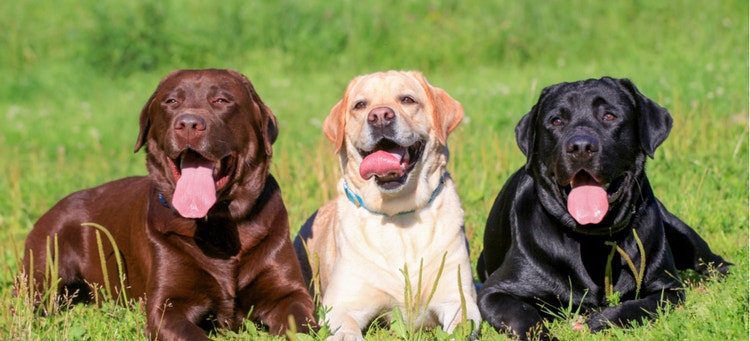
Labrador Retriever


Where Is the Labrador Retriever From?
Dating back to the early 1800s, the Labrador Retriever was first linked to the Canadian province of Newfoundland, despite obvious ties to the neighboring island of Labrador. The breed helped fisherman by swimming out to retrieve nets. Their “otter” tail, weather-resistant coat, and webbed toes made them expert swimmers and able to brave cold temperatures.
The breed found their way to Europe when Canadian fishermen began selling them to locals at English ports. Their patience and excellent scenting abilities allowed them to become desirable gun dogs. As more and more Labradors were imported by the English, they began to develop their own breeding programs. The Earl of Malmesbury, a well-known sportsman, dubbed the breed “Labrador Retriever” in the 19th century.
A decline in popularity occurred at the tail end of the century, caused by a halt in transportation from Canada due to quarantine laws and taxes. This inspired the cross breeding of the Labrador with the Curly-coated Retriever, Flat-coated Retriever, and Tweed Water Spaniel. The appearance of the Labrador remained relatively unchanged following cross breeding, but hunting abilities were enhanced.
In the early 1900s, the Labrador Retriever was acknowledged by the English Kennel Club. By 1917, the Labrador Retriever had arrived in the United States and was officially recognized by the American Kennel Club.
Caring for a Labrador Retriever

What Kind of Diet Does a Labrador Retriever Need?
What Kind of Diet Does a Labrador Retriever Need?
Labrador Retrievers need a diet fit for their level of activity and age group. Limiting treats and monitoring caloric intake is required, since they have a tendency to become overweight.

How Much Grooming Does a Labrador Retriever Need?
How Much Grooming Does a Labrador Retriever Need?
Labrador Retrievers require very little maintenance. The breed sheds regularly and only requires weekly brushing. Occasional baths and regular nail trimmings are all that’s needed to keep them looking their best.
They can be prone to ear infections, so it is recommended that ears are monitored closely and cleaned as needed.

Are Labrador Retrievers Healthy Dogs?
Are Labrador Retrievers Healthy Dogs?
Labrador Retrievers have been associated with several health concerns. As a hunting breed, they are prone to orthopedic issues. The first is hip dysplasia, which is a hereditary malformation of the hip joints that can result in pain, lameness, and arthritis. Symptoms of hip dysplasia can be minimized by weight management and avoiding overexertion. Another orthopedic issue is elbow dysplasia, which stems from abnormal development of the elbow joint, and can lead to arthritis and lameness.
Skin issues have been associated with Labrador Retrievers as well. Atopy, which is related to an environmental allergy, causes skin to become itchy and can lead to lesions if left untreated. Hot spots are also a common skin infection for Labs, which are caused by bacteria and lead to itchiness and pain.
The breed typically lives for 10 to 13 years.
Labrador Retrievers are predisposed to: gastric torsion, hip dysplasia, elbow dysplasia, progressive retinal atrophy, hemangiosarcoma, epilepsy, interdigital dermatitis, atopy, food allergy, mast cell tumors, perianal fistulas, lymphosarcoma, cataracts, glaucoma, lipomas, osteochondrosis, seborrhea, hot spots, diabetes mellitus, hypothyroidism, melanoma, ruptured cranial cruciate ligament, hypoadrenocorticism, nasal depigmentation, cutaneous histiocytoma, retinal detachment, ectropion, congenital idiopathic megaesophagus, lick granuloma, and myasthenia gravis.

How Much Training Does a Labrador Retriever Need?
How Much Training Does a Labrador Retriever Need?
Despite being smart and eager to please, Labrador Retrievers require early obedience training to rein in their exuberant nature. Consistent training as early as 6 to 8 months will help a Lab puppy grow into an obedient and loyal adult. Incorporating retrieving into training can help keep them motivated and engaged.

How Much Exercise Does a Labrador Retriever Need?
How Much Exercise Does a Labrador Retriever Need?
Labs require regular exercise. They truly enjoy swimming and retrieving, and these activities should be incorporated in their daily fitness regimen. If they are not exercised on a regular basis, they may begin eating from the trash or exhibiting destructive behavior. The entire family should take part in their favorite activities, such as playing fetch and catching the Frisbee.
What Are the Physical Characteristics of a Labrador Retriever?
Eye color varies based on coat color. Yellow and black Labrador Retrievers have brown eyes, while Chocolate Labs sport brown or hazel.
Chocolate Labs are also known for their brown noses, as opposed to the black noses possessed by yellow and black Labs.
Labrador Retriever Facts
Other Breeds to Explore
References
- Morris, Desmond. Dogs: The Ultimate Dictionary of Over 1,000 Dog Breeds. Trafalgar Square, 2002.
- American Kennel Club. The Complete Dog Book. Random House Digital, Inc., 2006.
- Wilcox, Bonnie and Chris Walkowicz. The Atlas of Dog Breeds of the World. T.F.H Publications, Inc., 1995.
- Labrador Retriever Dog Breed Information. American Kennel Club, 2021.
- AIS/PennHIP FAQ. ANTECH Imaging Services, 2016.
- What is Canine Hip Dysplasia?. Orthopedic Foundation for Animals. 2020


